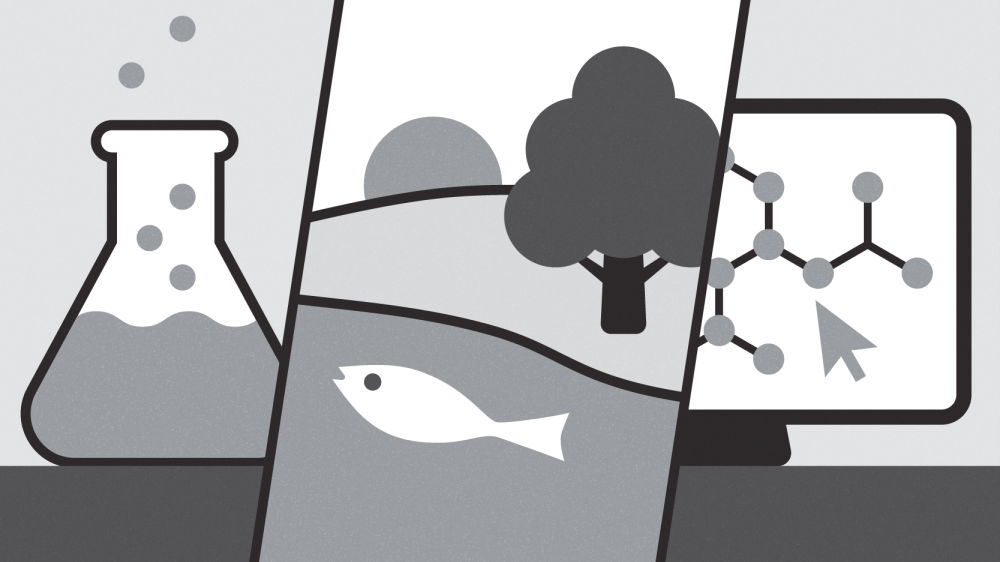NAMs: “Not a matter of if but of when”

Hear from the NC3Rs NAMs Advisory Group as they discuss their recent paper on how to overcome the hurdles to embedding new approach methodologies (NAMs) in chemical and drug safety assessment.
Contents
An explosion of interest and potential
“It is not a matter of if but of when” – This is what Dr Susy Brescia, Regulatory Toxicologist at the UK Health and Safety Executive, has to say when asked about the future of NAMs in regulatory testing. Whilst experts agree it may be some time before the use of animals for regulatory decision-making can be completely replaced, Susy goes on to say that “with further scientific and technology development, policy change and smarter validation, NAMs will gradually replace animal testing”.
It is a sentiment shared by her fellow members of the NC3Rs NAMs Advisory Group and our Head of NAMs Strategy, Dr Natalie Burden.
Natalie’s role is a new one – she took up the post last month after leading our ecotoxicology programme for over a decade: “I feel very privileged to be taking on this new role at such an exciting time for NAMs, given the explosion of scientific and political interest over recent years, and the huge potential they offer.”
This increasing interest has meant that the term ‘NAMs’ has come into common use, with some groups adopting the abbreviation to describe ‘non-animal methods’ more generally. The NC3Rs uses the definition broadly shared by industry and regulators where ‘NAMs’ describe ‘new approach methodologies’ – replacement technologies specifically used in assessing chemical or drug toxicity.
As Professor Ian Kimber, Chair of the NAMs Advisory Group, puts it:
“NAMs have the potential to improve the relevance of toxicity testing, through the incorporation of human cells and tissues, while simultaneously reducing reliance on safety assessments using experimental animals.”
Dr Carl Westmoreland from Unilever adds that “NAMs can [already] provide information for making many safety decisions today”.
To date, there are only a limited number of examples where NAMs have been used to provide regulatory safety data. Given the widely acknowledged benefits of NAMs and their potential to replace some of the millions of animals used in toxicology studies globally, why are they not more commonly used for decision-making in chemical safety assessment? And importantly, what steps are needed to transition from animal approaches to NAMs? These are the questions that the NAMs Advisory Group members set out to answer in a new publication, alongside NC3Rs Head of Toxicology Dr Fiona Sewell and Head of Innovation Dr Cathy Vickers. Ian tells us that “this paper seeks to provide a perspective on the identification of barriers that may limit the adoption of NAMs, and how in practice these may be overcome”.
From validation to application
The paper identifies four key types of barriers, described by Ian as “hurdles that must first be negotiated to realise fully the exciting opportunities that NAMs offer”. Ian stresses that NAMs must be “appropriately validated and applied” before they can be used to replace animal tests, and the paper identifies barriers not only within the status of the science, but also across the cultural, societal and regulatory landscapes:
- Technical and scientific barriers: The belief that NAMs should be benchmarked against animal data and the need to fully understand their relevance to human biology and risk assessment.
- Personal, cultural and societal barriers: Comfort with established methods and the need to ensure sufficient levels of protection to the public and the environment.
- Regulatory and legal barriers: Regulatory acceptance of NAM data, legislative constraints and the need for ‘official’ validation.
- Economic barriers: Significant cost and financial uncertainty and potential loss in return on investment for those developing NAMs.
The authors highlight the need for a coordinated approach to address these barriers and ensure that advances in science are paralleled by advances in regulation, skills, education and training.
Carl notes that “as well as continuing to make scientific progress, it is important to work with all stakeholders to understand how to increase uptake of this new science and build confidence in its application”.
Building collaboration, capacity and confidence
A central message of the paper is the collective responsibility of the whole scientific community. From researchers to regulators, discussions between stakeholders across academia, government and industry are needed to reach agreement on where NAMs can (and cannot) be used. To build these collaborations, we have recently formed the NAMs Network, a community of researchers, developers and industry and regulatory end-users working together to accelerate the use of NAMs.
International effort and investment and cross-sector collaboration will be required to develop and implement guidance on a realistic stepwise implementation of NAMs. Working with the British Toxicology Society, earlier this year we published a paper that identified actions to place the UK as a world leader with innovative chemicals regulation that embraces NAMs and firmly embeds the 3Rs. The first step towards building a consensus vision for a modern science-based approach to UK chemicals regulation came from a workshop we held with Unilever last year which brought together over 50 scientists from government departments responsible for implementing UK chemical safety policy, alongside representatives from industry and UK-based academic scientists. Carl noted that the workshop “clearly showed the enthusiasm of regulatory, industry and academic toxicologists in the UK for maximising the use of advanced safety science approaches to improve how we assure the safety of chemicals for consumers, workers and the environment”.
In addition to cross-stakeholder engagement, considerable investment in science and education will be required to capitalise on the opportunities for NAMs to improve protection of human and environmental health. Dr Camilla Alexander-White, Royal Society of Chemistry and MKTox Consultancy, says that “the introduction of NAMs into next-generation risk assessment for chemical safety will mean a whole range of new multidisciplinary skills are needed in the regulatory community”. Dr Clive Roper, Roper Toxicology Consulting Limited, emphasises the important role of those currently working with animals: “They have long known the strengths and weaknesses of their test and already help steer those working on NAMs in the right direction, contributing to further successes.”
Clive tells us that “the barriers are opportunities…to upscale their knowledge and experience into NAMs”.
Continuing to build the required skills across the science-base to support a NAMs pipeline from development to application is one of the goals recommended by the authors in the paper. We have been supporting NAMs science throughout our twenty-year history and our investment has reflected increased interest in recent years, with £10.4M committed to NAMs across our research and innovation funding portfolio in the last five years alone. Significant research investment is another action identified by the authors, particularly focusing on the application of machine learning approaches for toxicity modelling and emphasis on the capability of organ-on-chips. To date, we have invested £16M to develop, validate and apply NAMs in partnership with industry Sponsors through our CRACK IT Challenge programme, including computational models to replace the use of dogs in pharmaceutical toxicity testing and predict the potential of chemicals to disrupt human thyroid hormones.
The future is already here
The NC3Rs NAMs Advisory Group envisages a future in which NAM-based approaches are the default starting position for safety decision-making, with animal tests only justified where NAMs are not available or cannot reliably provide safety assurances. They suggest that current barriers to uptake are more to do with culture than the scientific quality and relevance of NAMs and propose a change in thinking is required.
Explaining this, Dr Richard Currie of the agriculture technology company Syngenta, paraphrases a quote from science fiction writer William Gibson:
"The future is already here – it's just not evenly distributed!”.
Richard goes on the explain that “there are already examples of [NAMs] use, although not all have made it to regulatory submission yet due to the long lead times for new chemical registrations”. He tells us that Syngenta “has already made a regulatory submission using NAMs and mathematical modelling, without new rodent toxicology studies, to inform human-relevant inhalation exposure risk assessment for pesticide products”.
The paper advocates for a modern safety testing paradigm in which NAM approaches do not aim to replicate the animal, but instead ensure that decisions made based on NAMs are protective for human and environmental health. To move towards this goal, the authors highlight three current opportunities to accelerate the adoption of NAMs in practice and policy:
- Where NAMs are already available and clearly reliable, and protective, for example for skin and eye irritation, skin sensitisation and genotoxicity, they should be required and accepted by regulatory authorities in place of animal methods.
- Where animal data is still deemed necessary, NAMs could be submitted and considered in parallel. Whilst many regulatory agencies already have mechanisms in place to enable this, significant investment will be required to support the extra resources required for generating and interpreting/assessing these ‘dual data’ packages.
- The evidence base for improved safety via NAMs should be collated and published to increase confidence in the regulatory acceptance of NAMs-based approaches.
Natalie says she is “looking forward to leading the NC3Rs strategy in this space – continuing to support the work already ongoing within our staff-led, research funding and CRACK IT teams – as well as working with existing and new stakeholders to establish new initiatives that will support the transition towards the widespread use of NAMs in practice”.
As advances in science and technology begin to translate to a real-world replacement of animal use for assuring the safety of chemicals and medicines, there are exciting opportunities for scientists entering the field of regulatory sciences.
As Camilla puts it:
“What a great time to become a toxicologist in this new landscape of human-relevant toxicology opportunities!”.
The NAMs Network is a community of researchers, developers and industry and regulatory end-users working together to accelerate the use of new approach methodologies.

Hear from NC3Rs Chief Executive, Dr Vicky Robinson, about how the NC3Rs works to replace the use of animals in toxicity testing with non-animal methods, a topic debated in Parliament in February 2024.

